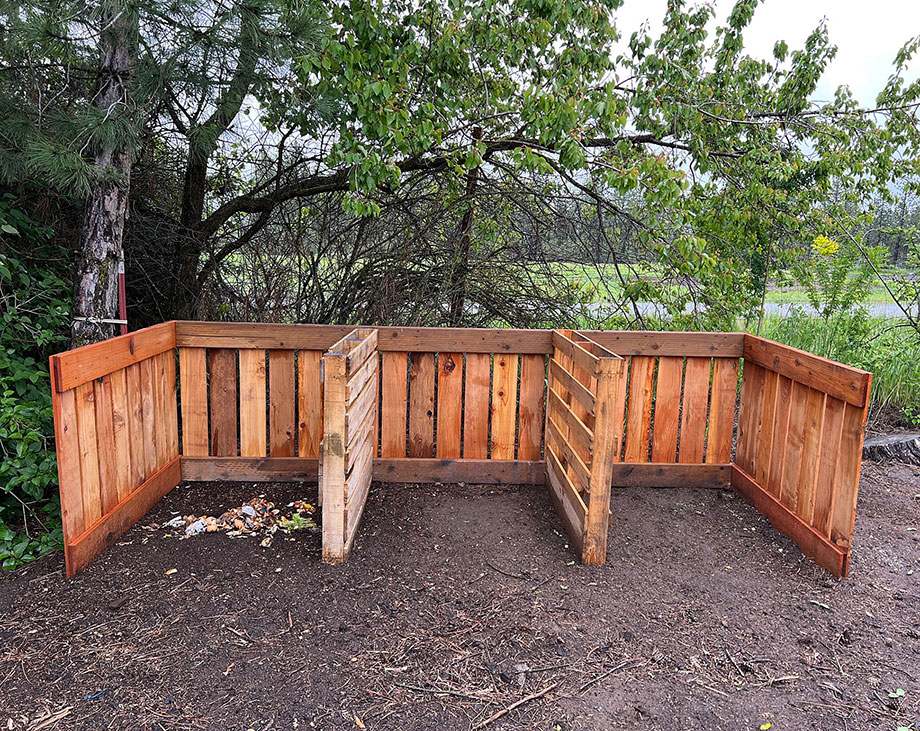June 19 Column: Compost

I am really excited about this week’s garden column and accompanying video! That’s because it is my mission to explain how simple it is to make your own compost. Sometimes we overcomplicate the process and feel daunted. Well, no more because I provide the basics of what you need to know in order to be successful.
You can read my column in today’s issue of The Spokesman-Review: Successful compost needs four things: brown material, green material, water, and oxygen. Or you can read the text of it underneath the video below.
In case you’re curious about our new composting system (pictured above), Bill and I recently constructed it with 2 free pallets and inexpensive fence boards so it would look decent from the outside. It’s a 3-bin system. I’ve been using a Compost Tumbler for years, and it works really well, but I really want to focus on producing more homemade compost this year. It seems like most gardeners share the same problem: we can never produce as much compost as we want, right?
I hope you’ll really enjoy my video and that it answers all of your questions. My motto is “keep it simple!”
Here’s my garden column on how to make your own compost:
Compost is an essential ingredient for a healthy, productive vegetable garden. It can be easy to overthink the process but it’s not complicated to make your own.
Compost is decayed organic material that you can use as a soil amendment. Every spring, I apply 1 to 2 inches of compost to the surface of my raised beds. I don’t have to work it into the soil because the nutrients filter down into it over time.
To be successful at making compost, you need four main elements: brown materials (which provide carbon), green materials (nitrogen), oxygen and moisture. The general rule of thumb is to add twice as much brown materials as green to the pile.
Examples of brown materials include animal bedding such as straw or sawdust, torn-up cardboard, dead plant material, eggshells, dried leaves, and shredded paper or newspaper. Green materials can be coffee grounds, grass clippings (provided you don’t use herbicides on your lawn), kitchen scraps such as vegetable or fruit peelings, green plant material, tea bags and droppings from chickens or rabbits.
It’s also important to note what shouldn’t be added to a compost pile. This includes meat or fish, dairy products, cooking oils, difficult-to-control weeds that have seed heads, and diseased plant materials. Avoid using manure from carnivorous animals because there will be pathogens within it. Also be aware that manure from horses or cows can contain persistent herbicides which will adversely impact your garden for several years before finally dissipating.
You can keep your compost-making system simple by creating a pile on the ground in your vegetable garden or building a compost bin set-up that has two or three bays. If you’re dealing with nuisance animals such as rats, raccoons, groundhogs or skunks, it’s a good idea to use a closed, commercial system. Most of these products have a handle that you can turn to mix the pile contents together. There also are containers that you roll on the ground to accomplish the same purpose.
When building your pile, remember that if you chop the materials into smaller pieces, they will decompose more quickly. Try to keep the pile size to roughly 3 feet square and high. Add a bit of water but don’t go overboard. You want the pile to be lightly moist, not sopping wet.
I mentioned how oxygen is one of the four important components of a successful compost pile. It is essential for the organisms that break down the materials. When you occasionally turn the pile with a shovel or spading fork, that will reincorporate air within it.
Once I’ve built a pile, I like to insert a soil or compost thermometer because it is fun watching the temperatures rise within it. Throughout the decomposition process, the temperatures will go up and down multiple times.
If your compost pile starts smelling unpleasant, that means it’s either too wet or it needs to be turned to increase the amount of oxygen within the materials. Once you address that, the problem should resolve.
There are two approaches to making compost: hot composting and cold composting. The former involves turning the pile about once per week, which speeds up decomposition and yields finished compost in a few months. While the latter involves minimal turning, it can take about a year before the compost is ready to add to your garden.
Once the compost is nice and crumbly and has a pleasant, earthy smell, it is finished. Learn more about home composting in this week’s video at youtube.com/susansinthegarden.
Susan Mulvihill is author of “The Vegetable Garden Pest Handbook.” She can be reached at Susan@SusansintheGarden.com.

